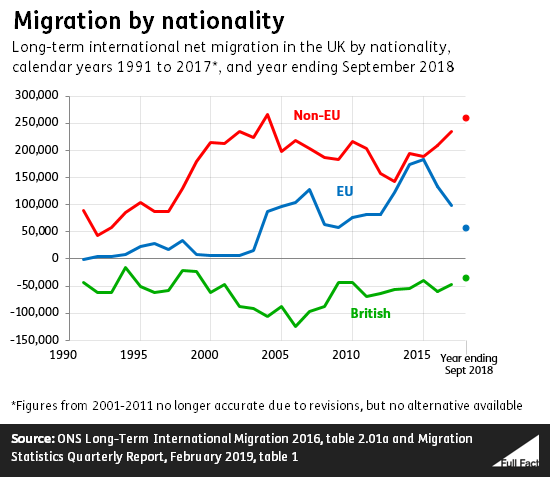EU immigration to the UK
An estimated 202,000 citizens from other EU countries immigrated to the UK in the year to September 2018, and about 145,000 emigrated abroad. So EU ‘net migration’ was around 57,000—roughly the lowest level recorded since 2009.
In the year before the referendum, net EU migration was estimated at 189,000, so there’s been a large fall following the vote. We don’t know how much of that is a direct result of the decision to leave, but that and the Brexit process over the past few years has clearly had an impact.
Madeleine Sumption, from the Migration Observatory at the University of Oxford, commented:
“The overall story the data tell on EU migration is clear: Britain is not as attractive to EU migrants as it was a couple of years ago. That may be because of Brexit-related political uncertainty, the falling value of the pound making UK wages less attractive, or simply the fact that job opportunities have improved in other EU countries. EU net migration happened to be unusually high in the run-up to the referendum, so at least some of this decline would probably have happened anyway even without Brexit.”
Estimated non-EU net migration, meanwhile, is 261,000 a year—the highest level recorded since 2004. It has been almost consistently higher than EU migration for decades.

Join 72,953 people who trust us to check the facts
Sign up to get weekly updates on politics, immigration, health and more.
Subscribe to weekly email newsletters from Full Fact for updates on politics, immigration, health and more. Our fact checks are free to read but not to produce, so you will also get occasional emails about fundraising and other ways you can help. You can unsubscribe at any time. For more information about how we use your data see our Privacy Policy.
Fewer EU citizens are immigrating to the UK, and more are emigrating
The most recent set of figures published cover the year to September 2018.
Since the EU referendum in late June 2016, the estimated number of EU nationals immigrating to the UK fell from 284,000 the year before the vote to 226,000 in the year after. That’s now down to 202,000.
Meanwhile the number of EU citizens emigrating has increased from an estimated 95,000 in the year before the referendum to 145,000 now.
The numbers are uncertain
These figures have a margin for error because they’re mainly based on surveys of passengers at airports. Net migration from the rest of the EU in any one year could usually be around 30,000 more or less than the estimates.
That means that small changes in immigration from one period to the next might not actually represent what’s really happening. With larger changes we can be more certain.
These figures also define immigrants and emigrants as people who change their country of residence for at least a year—which is called ‘long-term migration’. There are separate estimates for the numbers of people who come to the UK for less than a year.
There’s been controversy over whether long-term estimates accurately reflect immigration at all.
Reasons for coming here
About four in ten citizens from other EU countries say they come with a definite job lined up. Others usually come looking for work, to study or to join family members in the UK.
Non-EU immigrants, mainly say they come to study.

EU net migration was at historically high levels, but is now falling back
In recent years annual net migration from the rest of the EU has been at historically high levels. In the two years up until September 2016 it was between an estimated 160,000 to 190,000. Back in 2012 it was nearer 70,000 a year.
As the Migration Observatory at the University of Oxford points out, when the EU expanded in 2004, the UK was one of three countries which opened its borders straight away to workers from the new member states.
The new estimates for the year to September 2018 suggest EU net migration has now returned to a level similar to that last seen in 2009.
3.7 million EU citizens in the UK
Around 3.7 million people living in the UK in 2018 were citizens of another EU country. That’s about 6% of the UK population, although these figures exclude people who live in communal establishments. Similarly, 6% of the UK population were born in another EU country.
Around 2.3 million nationals of other EU countries are in work, as of October to December 2018.
EU nationals of working age are more likely to be in work than UK nationals and non-EU citizens. About 83% of working age EU citizens in the UK are in work, compared to around 76% of UK nationals and 66% of people from outside the EU.
1.3 million people from the UK live in the rest of the EU
Figures for 2017 suggest that 1.3 million people born in the UK live in other EU countries. We’ve previously looked at all the estimates in detail.
Update 7 June 2017
We updated one of the figures in the 'reasons given for immigrating to the UK' graph from 41% to 42% to account for rounding error.